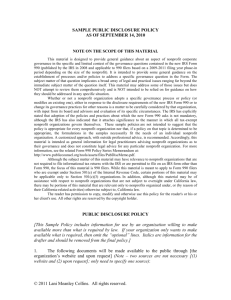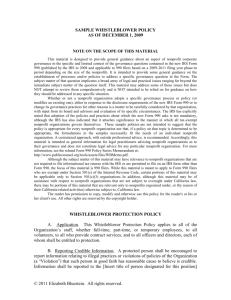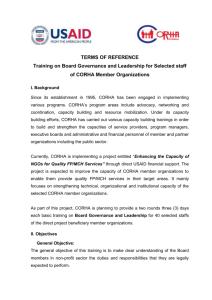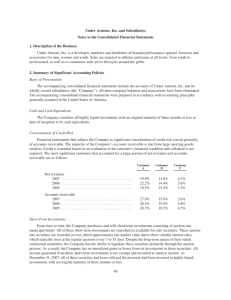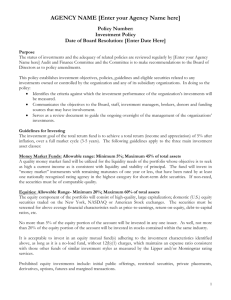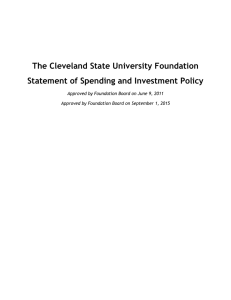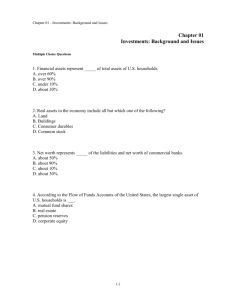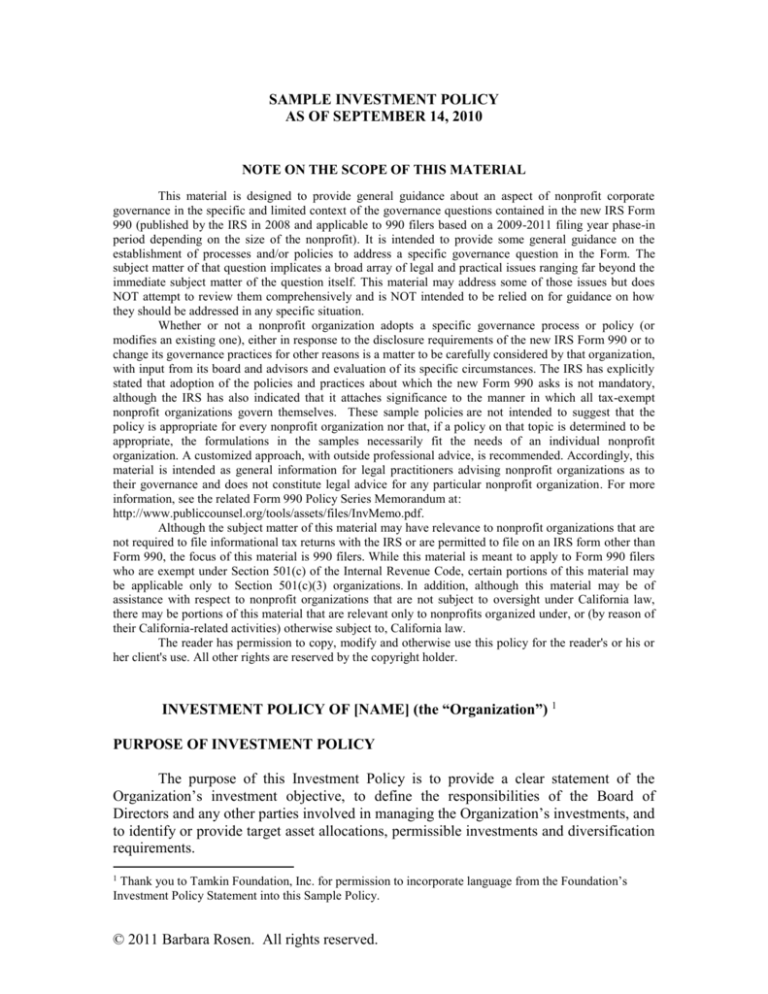
SAMPLE INVESTMENT POLICY
AS OF SEPTEMBER 14, 2010
NOTE ON THE SCOPE OF THIS MATERIAL
This material is designed to provide general guidance about an aspect of nonprofit corporate
governance in the specific and limited context of the governance questions contained in the new IRS Form
990 (published by the IRS in 2008 and applicable to 990 filers based on a 2009-2011 filing year phase-in
period depending on the size of the nonprofit). It is intended to provide some general guidance on the
establishment of processes and/or policies to address a specific governance question in the Form. The
subject matter of that question implicates a broad array of legal and practical issues ranging far beyond the
immediate subject matter of the question itself. This material may address some of those issues but does
NOT attempt to review them comprehensively and is NOT intended to be relied on for guidance on how
they should be addressed in any specific situation.
Whether or not a nonprofit organization adopts a specific governance process or policy (or
modifies an existing one), either in response to the disclosure requirements of the new IRS Form 990 or to
change its governance practices for other reasons is a matter to be carefully considered by that organization,
with input from its board and advisors and evaluation of its specific circumstances. The IRS has explicitly
stated that adoption of the policies and practices about which the new Form 990 asks is not mandatory,
although the IRS has also indicated that it attaches significance to the manner in which all tax-exempt
nonprofit organizations govern themselves. These sample policies are not intended to suggest that the
policy is appropriate for every nonprofit organization nor that, if a policy on that topic is determined to be
appropriate, the formulations in the samples necessarily fit the needs of an individual nonprofit
organization. A customized approach, with outside professional advice, is recommended. Accordingly, this
material is intended as general information for legal practitioners advising nonprofit organizations as to
their governance and does not constitute legal advice for any particular nonprofit organization. For more
information, see the related Form 990 Policy Series Memorandum at:
http://www.publiccounsel.org/tools/assets/files/InvMemo.pdf.
Although the subject matter of this material may have relevance to nonprofit organizations that are
not required to file informational tax returns with the IRS or are permitted to file on an IRS form other than
Form 990, the focus of this material is 990 filers. While this material is meant to apply to Form 990 filers
who are exempt under Section 501(c) of the Internal Revenue Code, certain portions of this material may
be applicable only to Section 501(c)(3) organizations. In addition, although this material may be of
assistance with respect to nonprofit organizations that are not subject to oversight under California law,
there may be portions of this material that are relevant only to nonprofits organized under, or (by reason of
their California-related activities) otherwise subject to, California law.
The reader has permission to copy, modify and otherwise use this policy for the reader's or his or
her client's use. All other rights are reserved by the copyright holder.
INVESTMENT POLICY OF [NAME] (the “Organization”) 1
PURPOSE OF INVESTMENT POLICY
The purpose of this Investment Policy is to provide a clear statement of the
Organization’s investment objective, to define the responsibilities of the Board of
Directors and any other parties involved in managing the Organization’s investments, and
to identify or provide target asset allocations, permissible investments and diversification
requirements.
Thank you to Tamkin Foundation, Inc. for permission to incorporate language from the Foundation’s
Investment Policy Statement into this Sample Policy.
1
© 2011 Barbara Rosen. All rights reserved.
INVESTMENT OBJECTIVE
The overall investment objective of the Organization is to maximize the return on
invested assets while minimizing risk and expenses. This is done through prudent
investing and planning, as well as through the maintenance of a diversified portfolio.
GENERAL PROVISIONS
All transactions shall be for the sole benefit of the Organization.
The Directors shall consider updating the Organization’s investment policy on an
annual basis.
The Directors shall conduct an annual review of the Organization’s investment
assets to verify the existence and marketability of the underlying assets or satisfy
themselves that such a review has been conducted in connection with an
independent audit (if any) of the Organization’s financial statements.
Any investment that is not expressly permitted under this Policy must be formally
reviewed and approved by the Directors.
The Directors will endeavor to operate the Organization’s investment program in
compliance with all applicable state, federal and local laws and regulations
concerning management of investment assets [including IRC §4944 if the
Organization is classified as a private foundation for federal tax purposes.]
Investments shall be diversified with a view to minimizing risk.
DELEGATION OF RESPONSIBILITY; RELIANCE ON EXPERTS AND
ADVISORS
The Board of Directors has ultimate responsibility for the investment and
management of the Organization’s investment assets.
The Board may delegate authority over the Organization’s investments to a
properly formed and constituted Investment Committee, being a Board
Committee comprised only of directors.
The Board or Board Committee may hire outside experts as investment
consultants or investment managers.
The Board may also establish an advisory committee (which may include nondirectors) to provide investment advice to the Board or to the Board Committee.
Advisory committees have no authority to act for the Board, but may monitor
2
compliance with the investment policy, recommend changes, and assist the Board
or Board Committee in selecting and retaining Investment Managers to execute
this Investment Policy.
RESPONSIBILITIES OF THE BOARD, OR IF AUTHORITY IS DELEGATED,
THE INVESTMENT COMMITTEE
The Board, or if authority is delegated, the Investment Committee, is charged
with the responsibility of managing the investment assets of the Organization. The
specific responsibilities of the Board or the Investment Committee, as applicable,
include:
1. Communicating the Organization’s financial needs to the Investment
Managers on a timely basis.
2. Determining the Organization’s risk tolerance and investment horizon and
communicating these to the appropriate parties.
3. Establishing reasonable and consistent investment objectives, policy
guidelines and allocations which will direct the investment of the assets, to be
reviewed by the Board on an annual basis.
4. Prudently and diligently selecting one or more qualified investment
professionals, including investment managers(s), investment consultant(s),
and custodian(s).
5. Regularly evaluating the performance of investment manager(s) to assure
adherence to policy guidelines and to monitor investment objective progress.
6. Developing and enacting proper control procedures; e.g., replacing investment
manager(s) due to a fundamental change in the investment management
process, or for failure to comply with established guidelines.
RESPONSIBILITIES OF INVESTMENT MANAGERS
Each investment manager will invest assets placed in his, her or its care in
accordance with this investment policy.
Each investment manager must acknowledge in writing acceptance of
responsibility as a fiduciary.
Each investment manager will have full discretion in making all investment
decisions for the assets placed under his, her or its care and management, while
operating within all policies, guidelines, constraints, and philosophies outlined in
3
this Investment Policy.
include:
Specific responsibilities of investment manager(s)
1. Discretionary investment management, including decisions to buy, sell, or
hold individual securities, and to alter allocation within the guidelines
established in this statement.
2. Reporting, on a timely basis, monthly investment performance results.
3. Communicating any major changes in the economic outlook, investment
strategy, or any other factors that affect implementation of investment process.
4. Informing the Board, or if authority is delegated, the Investment Committee,
regarding any changes in portfolio management personnel, ownership
structure, investment philosophy, etc.
5. Voting proxies, if requested by the Board, or if authority is delegated, the
Investment Committee, on behalf of the Organization.
6. Administering the Organization’s investments at reasonable cost, balanced
with avoiding a compromise of quality. These costs include, but are not
limited to, management and custodial fees, consulting fees, transaction costs
and other administrative costs chargeable to the Organization.
GENERAL INVESTMENT GUIDELINES
A copy of this Investment Policy shall be provided to all Investment Managers.
The Organization is a tax-exempt organization as described in section 501(c)(3)
[or section 501(c)(6), etc., as applicable] of the Internal Revenue Code. This taxexempt status should be taken into consideration when making Organization
investments.
The Organization is expected to operate in perpetuity; therefore, a 10 year
investment horizon shall be employed. Interim fluctuations should be viewed with
appropriate perspective. [The foregoing may or may not be included, as
applicable, depending upon the Organization’s liquidity requirements.]
A cash account shall be maintained with a zero to very low risk tolerance to keep
cash available for grant distributions, tax obligations and other anticipated
expenses.
Transactions shall be executed at reasonable cost, taking into consideration
prevailing market conditions and services and research provided by the executing
broker.
4
Permitted investments include: [Provide a list of permitted investments here] Cash
and cash equivalents, marketable securities including equities and fixed income
securities, _______, _______.
[Note: The Organization should determine its own credit quality standards and
prohibited transactions, based on its investment objectives and risk tolerance. The
following two bullet items represent samples only and are not recommended for use
without review by investment counsel.]
No fixed income security shall have an equivalent credit quality below investment
grade at the time of purchase, defined as:
1. BBB by Standard & Poors for straight bonds and convertibles
2. Baa3 by Moody’s Investor Service for straight bonds and convertibles
3. A1 by Standard & Poors for short term securities
4. P1 by Moody’s Investor Service for short-term securities
5. AAA for money market accounts
The following transactions are prohibited: Purchase of non-negotiable securities,
derivatives, high risk or junk bonds, private placements, precious metals,
commodities, short sales, any margin transactions, straddles, warrants, options,
life insurance contracts, leverage or letter stock.
DIVERSIFICATION
The Organization will maintain a reasonable diversification of investment assets
between asset classes and investment categories at all times.
Investments in the equity securities of any one company shall not exceed [5%] of
the portfolio nor shall the total securities position (debt and equity) in any one
company exceed [10%] of the portfolio.
Reasonable sector allocations and diversification shall be maintained. No more
than [25%] of the entire portfolio may be invested in the securities of any one
sector.
Investments within the investment portfolio should be readily marketable.
The investment portfolio should not be a blind pool; each investment must be
available for review.
5
ASSET ALLOCATION
The asset allocation policy shall be predicated on the following factors:
1. Historical performance of capital markets adjusted for the perception of the
future short and long-term capital market performance.
2. The correlation of returns among the relevant asset classes.
3. The perception of future economic conditions, including inflation and interest
rate assumptions.
4. Liquidity requirements for the projected grants and other charitable
expenditures.
5. The relationship between the current and projected assets of the Organization
and projected liabilities.
ALLOCATION RANGE
[Note: The Organization should determine its own allocations, based on its investment
objectives and cash needs. The following allocation schedule is only a sample and is not
recommended for use without review by investment counsel.]
Asset Allocation Range
Target
Upper limit
Cash & Equivalents
5%
0 – 15%
Fixed Income
40%
20 – 60%
Equities: Domestic Large Cap
25%
20 – 40%
Equities: Domestic Small/Mid Cap
20%
10 – 25%
Equities: International
10%
5 –15%
Rebalancing shall be done on a semi-annual basis or more frequently if deemed
necessary.
PERFORMANCE
Performance objectives are to be met on a net of fees basis. The investment
performance of each asset allocation class will be measured on two levels: against
inflation objectives for the total Organization and against index objectives for
individual portfolio components. Investment performance shall be measured no
6
less than quarterly on a net of fees basis. Performance shall be evaluated on a
three to five year basis to allow for market fluctuations and volatility.
*****************
7


